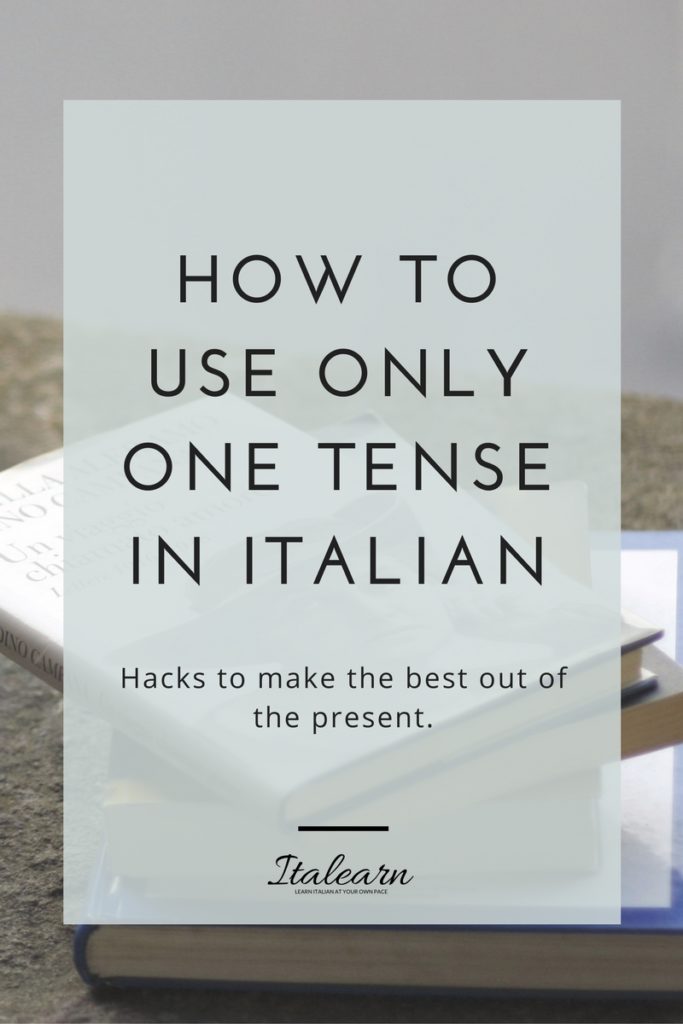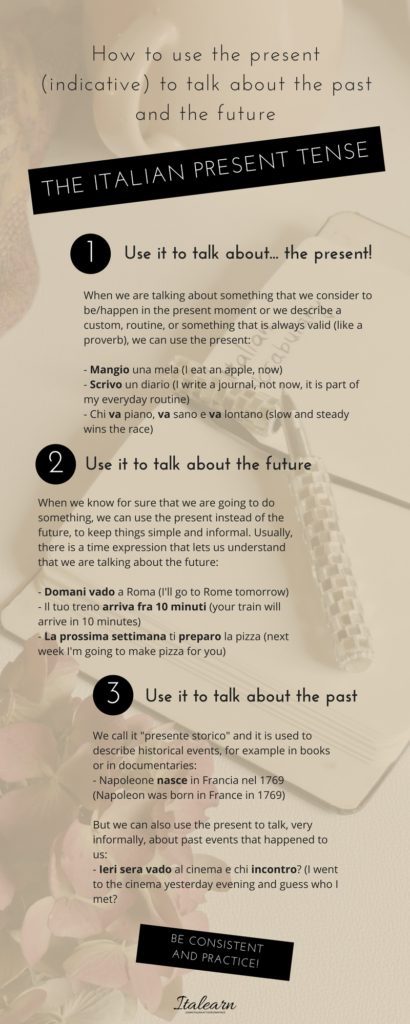Let me start with a question: what do you find most difficult to learn in Italian?
Verbs!
That’s what you wanted to say too, right? Even Italians say it because they often need to double check their verbs.
Is the mood correct?
Is the person correct?
Is the spelling correct?
In Italian we say “mal comune, mezzo gaudio” which means that you feel a little relieved knowing that your problem is shared by other people.
Of course this doesn’t mean that your problem is solved just because it is shared, in this case it means that you are not alone in the verbs battle and you can learn strategies to limit their power of messing your conversations up.
For me the best strategy is always to simplify. I know that when you are speaking it is difficult to stop and think, but you can certainly do it and without interrupting the flow of ideas or looking weird.
So let’s see how to do this first: how can you stop and think of the right verb in the middle of a conversation? And, how can you actually make it a part of the conversation?
I’ll give you two examples.
- You just go ahead and say the verb without thinking too much, if you feel it is not correct just add something like this:
- oh, I said [verb] is it ok? Here you are asking for the correct verb.
- Oh, I said [verb] is it ok or should I say [verb] instead. Here you are asking to confirm your guess.
Don’t keep this too long or it will be a conversation about verbs, say thank you for the answer and go on with what you were saying, you can resume like this: so, what I was saying is… (allora, dicevo…).
Now let’s see this technique in action, in Italian:
“Ieri sera ho andato al cinema e, ops, dico bene/è giusto?”
“Ieri sera ho andato al cinema e, ehm, si dice ho oppure sono?”
(Right answer at the end of the post).
2. You know some of your verbs may not be correct, but this won’t stop your talking, so even if you hear yourself saying the wrong tense or using the wrong auxiliary you just leave your thoughts aside and go ahead, you’ll practice your verbs later.
The point is that you don’t have to overthink and feel bad if you don’t get the verb correctly, simplify by getting a correction and going on or by not even stopping about thinking at your verbs!
As I said in the beginning, verbs are difficult for native speakers too, but you can turn around some problems and get out of your language lump perfectly.
When you listen carefully to how Italians speak, you’ll notice that they don’t follow grammar rules strictly. This happens a lot with verbs tenses, there is a good degree of flexibility on why you choose one verb tense over another.
The present tense of the indicative mood is the perfect example. It is used very often in conversations in the place of the past and the future. Here is how the simplify rule comes into play again. It is always important that you have a clear picture of the context
- Is the conversation informal?
- Do I know the people I am talking to?
- Is there a prequel I need to know?
But don’t forget that you are still a beginner speaker, so even if I sound repetitive: don’t overthink!
Watch this video (made of four short video lessons I have published on Instagram) and we’ll go through more examples after it.
So, we have 3 tenses that can be substituted by the present (even more of them if we consider a couple of past tenses that could be used, depending on the speaker).
That’s because the speakers of the language, through the decades, have looked for ways to make their life easier. Now some of these “hacks” are normal, they are accepted by Italian speakers, but as a beginner student you may only have heard about the textbook version of the story.
Listening is equally important as speaking, maybe even more important than speaking. When you listen, you create a mental image of the situation and you instinctively opt for the word or sentence that best fits that context. The ability of listening is something that you should cultivate, it’s your ally.
Listen to native speakers in casual conversations as often as you can. If you don’t have the possibility to do it in person, just watch television or a recent Italian movie. Listen only to short clips, or you’ll just feel overwhelmed.
In the printable below you can find more examples of how to use the present to talk about the past, the future, and the present of course!
The desire to speak perfectly and fluently will always be there, but we are human and we cannot have everything under control all the time. Yes, we can control what we say, but at the end of the day, grammar or pronunciation mistakes are not that relevant.
Did the people you were talking to understand?
Did you get exactly what you asked for?
Did you enjoy your conversation?
These are the ultimate questions you need to ask yourself, you’ll have time tomorrow to practice your verbs more, now it’s time for an aperitivo!
PS: the right answer is sono andato.


Get better at Italian through creative exercises. Sign up for the free mini-course A story and 5 creative ways to fall in love with Italian and I'll send you the story straight away.
PS: no artistic skills required!
Thank you!
Check your inbox! You have just received an email from me so you can confirm that you really, really want to receive the free guide and updates from me.
Silvia




